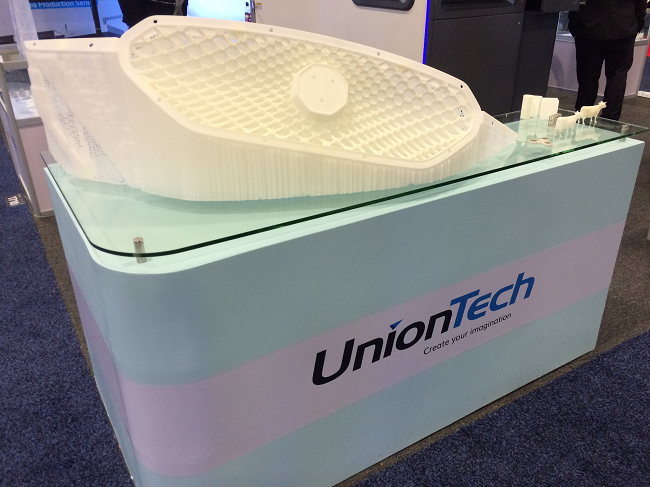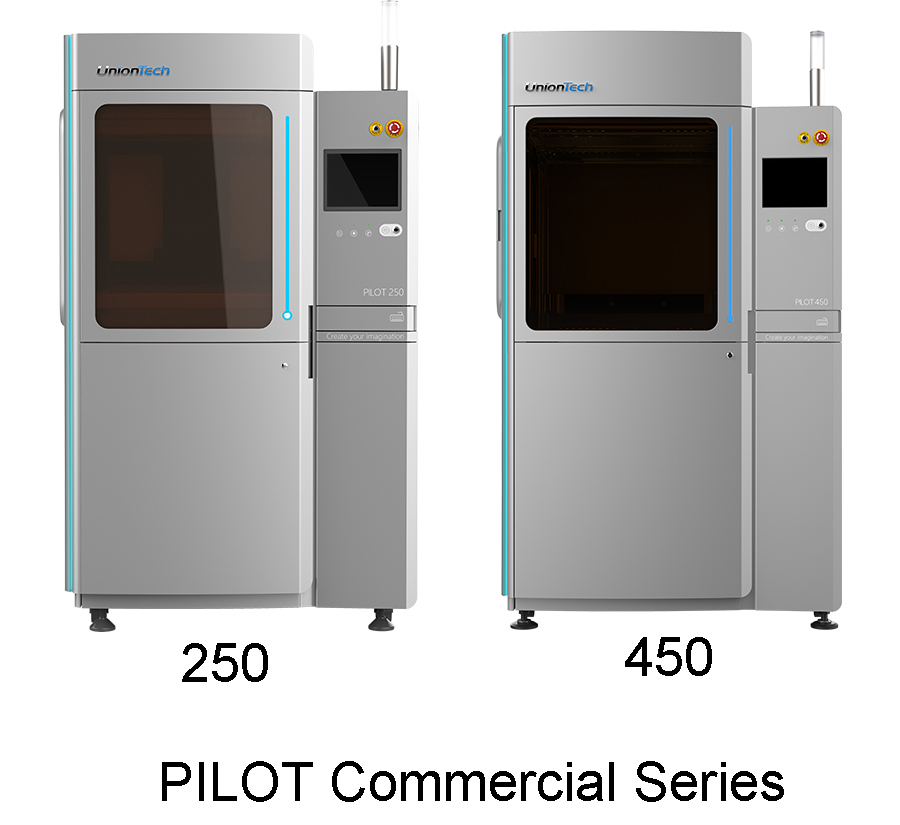While many used to think that SL 3D printing was only for prototyping, the technology is now used often for patterns and toolings, like the ones found in injection molding, investment casting, thermoforming, and urethane molding. That’s why UnionTech provides 3D printed solutions for multiple applications, including aerospace, automotive, aerospace, industrial, and medical, and its entire product line is based on internationally sourced components, such as, Panasonic, Advanced Optowave, and SCANLAB.
As Jim Reitz, the General Manager of UnionTech, told me at RAPID 2018 in April, most of the company’s competitors use RFID, which means lots of bottles constantly pumping in and out. But thanks to its open source 3D printers, UnionTech can avoid this issue while also keeping things cost-effective. Because its 3D printers can work with any 350 nanometer wavelength material, such as what Somos offers, UnionTech’s technology also opens up the market segment for users even wider.
I also learned at RAPID that the company had recently opened a brand new facility in St. Charles, a city in Illinois about 40 miles west of Chicago. This week, we learned a little more about the new location, which is actually a demonstration center for stereolithography 3D printing.
“The center’s purpose is to provide a convenient venue for a first-hand, close-up examination and hands-on evaluation of the UnionTech “fresh dimensions” approach to stereolithography: open sourced materials and software options, and robust “keep it simple and solid” engineering that provides cost-effectiveness with excellent part aesthetics,” said Reitz.
There are a lot of options out there when it comes to SL technology. That’s why UnionTech opened its new demonstration center – it wanted a way to facilitate the efforts of its potential paying customers in getting a good look at the numerous advantages and benefits of its commercial and production SL 3D printing equipment for themselves.
UnionTech’s SL demonstration center, which officially opened early in the second quarter of 2018, provides those who evaluate 3D printers with hands-on access all year long to its application knowledge and 3D printing equipment.
The center currently showcases the company’s industrial RSPro 600 and 800 3D printers – visitors can inspect this equipment and have it demonstrated, along with UnionTech’s commercial PILOT line. This series includes the PILOT 250 and PILOT 450, both of which can 3D print parts in Somos Element, EVOLVE, and WaterShed materials.
UnionTech’s new SL product demonstration center provides many functions, including the opportunity to discuss possible prototyping applications and applications in investment casting, metal clad composites, and rapid tooling with employees. The facility also showcases UnionTech’s equipment, while also accommodating final assembly and managing quality control of this equipment. In addition, it provides both warehouse and logistic support for customer shipments, and can be used to perform benchmark part builds, so potential customers can evaluate UnionTech’s technology up close.
According to the company itself, the features that its SL 3D printers comprise include the freedom to innovate and collaborate, which comes from its open design for machine and materials access. UnionTech’s SL 3D printers also provide cost-effective ownership throughout the entire life cycle of a product, and the high-quality surface aesthetics its technology provides to 3D printed parts can help contribute to reduced post-processing and finishing requirements.
Discuss this story and other 3D printing topics at 3DPrintBoard.com or share your thoughts in the comments below.
Subscribe to Our Email Newsletter
Stay up-to-date on all the latest news from the 3D printing industry and receive information and offers from third party vendors.
Print Services
Upload your 3D Models and get them printed quickly and efficiently.
You May Also Like
Consolidation in AM: How 2025 Is Shaping the Industry’s New Normal
The first half of 2025 has been marked by a clear shift in the additive manufacturing (AM) industry. Companies are no longer just focused on developing new tech by themselves....
Etsy Design Rule Change Reduces Selection of 3D Printed Goods
Online marketplace Etsy has implemented a rule change requiring all 3D printed goods on the site to be original designs. The update to the site’s Creativity Standards states, ¨Items produced using...
U.S. Congress Calls Out 3D Printing in Proposal for Commercial Reserve Manufacturing Network
Last week, the U.S. House of Representatives’ Appropriations Committee moved the FY 2026 defense bill forward to the House floor. Included in the legislation is a $131 million proposal for...
Transforming From Tourist to Native: Duro CEO Michael Corr Explains Why the Company Rebuilt its PLM Software on AI
In these early innings of the AI boom, many market analysts have expressed concern that AI spend has gotten too far ahead of the technology’s proven ability to deliver significant...




































